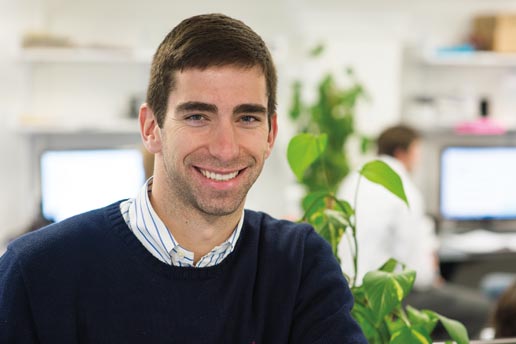
Michael Kearney SM ’11

After earning a master’s degree from the Technology and Policy Program in 2011, Michael Kearney had no time to catch his breath. He had already begun work at Ambri, formerly the Liquid Metal Battery Corporation, a Cambridge startup founded by Donald Sadoway, the John F. Elliott Professor of Materials Chemistry at MIT. Kearney credits this unique career opportunity directly to his experiences while a Hess-MIT Energy Fellow appointed to support the MIT Energy Initiative (MITEI) symposium “The Electrification of the Transportation System: Issues and Opportunities.”
Is this what you expected to be doing after MIT?
I didn’t know much about entrepreneurship when I started graduate school. I assumed I would eventually end up in DC involved in policy. But at MIT my eyes were opened to a world I’d never before imagined, where people were inventing the future they wanted to see. I first met Professor Sadoway at a symposium on the electrification of transportation, which I had helped organize for MITEI. Several months later, at an MIT Energy Club event, Ambri’s CTO Dave Bradwell asked me to join them getting the company off the ground. They needed me before I finished MIT. There was another complication: I was halfway out the door for a year in China as a Luce Scholar.
There are very few times in life when you have the opportunity to work at a company that could fundamentally change the world. I made the decision to start in April and was at Ambri a week later, still in the throes of writing my thesis.
What’s it like working for a startup?
It’s a little bit of thrilling and terrifying; I don’t get a lot of sleep. I work on everything necessary for setting up a company: human resources, government relations, marketing, modeling our business proposition.
I had no engineering background coming into this, and I’m not working with the technology itself, but I know what we’re doing here is unique. The concept is a new approach to grid-scale energy storage. The key to our plan is ensuring that the liquid metal battery technology achieves a price point that will work in the market. It is the kind of battery that can help integrate renewables like wind and solar into the grid, and ease shortages when power plants have problems meeting demand. We can save money for lots of different players.
What aspects of your MIT education are proving most useful to you?
The opportunities I had through the Energy Initiative were invaluable. My research for the electrification symposium acquainted me with all the related fields: battery technology, electrical grid, the policy side. My MITEI mentors, Ernie Moniz and Melanie Kenderdine, taught me a lot about energy policy, and as an Energy Fellow, I had access to high-level guests in the energy space. I found myself at one point talking about vehicle electrification with the British foreign secretary, David Milliband. These experiences have served me well.
Barbara Brenda Botros PhD ’11

When she left MIT in 2011 with a PhD in energy science and engineering, Barbara Brenda Botros knew she wanted to apply her extensive knowledge of thermodynamics, fluid mechanics, and aerodynamics to “innovative projects whose ultimate goal was making systems more energy efficient.” She landed at United Technologies Research Center. It’s a workplace, says Botros, where researchers are encouraged to investigate areas outside their home disciplines and where, “if you play your cards right, you can make a real impact.”
Did you envision a career in the energy field when you began your education?
After I saw Apollo 13 as a teenager, I wanted to be an astronaut. I went to McGill University headed for aerospace, and I even interned at the Canadian Space Agency junior year. But while studying mechanical engineering, I developed a passion for thermofluids and then researched detonations and combustions with a terrific professor.
I came to MIT still thinking about aerospace and for my master’s conducted Air Force-funded research on reducing the weight of plane engines. I developed the B3 parameter (named for my initials), an innovative design guideline for making compressors more efficient.
But when I began my PhD, I switched back to thermodynamics, which I very much loved. I joined the BP-MIT Energy Conversion [Research Program] on coal gasification with carbon capture. With Professor John Brisson [of mechanical engineering], I researched improving heat transfer processes in coal plants, which led to publishing papers and a patent. During this time, I broadened my horizons around energy research through MITEI conferences and the MIT Energy Club. An entirely new world opened up for me, and I realized that my work in fundamental sciences has so many potential applications in energy.
What is the focus of your current work, and how does your MIT background come into play?
My main focus in the aerodynamics group is developing a new line of high-efficiency compressors in industrial-size Carrier air conditioners for refrigerants with low global warming impact.
I found that because of MIT’s multidisciplinary environment—in research and elsewhere—I began work here well prepared for the demands of my project and knowledgeable about other areas of energy research. I can comfortably approach colleagues about their work and about potential collaborations. I’m not afraid to step outside of my comfort zone to learn something new. I already have some ideas for the center’s innovation pipeline, including ways to reduce noise and emissions in planes.
What kind of impact do you hope to make in your career?
The energy field is broad, and you can make an impact, whether by improving the energy efficiency of existing systems or by coming up with new systems altogether that produce or save energy. I like the idea of looking for the next big thing, the new Facebook or Twitter of the energy domain. I hope to be part of something that revolutionizes the energy sector.
F. John Burpo ScD ’12

After 20 years, F. John Burpo ScD ’12 and Eni-MIT Energy Fellow is returning to West Point, the launchpad for his uncommon career straddling military service and scientific research. A decorated officer with a Purple Heart and Bronze Star, Burpo conducted his principal graduate research in the Biomolecular Materials Group of Angela Belcher, the W. M. Keck Professor of Energy.
You have alternated between field duty and academia. Is it difficult negotiating two such different environments?
It is challenging to be competent and successful in each field, especially when you have to overcome stereotypes and allay concerns. When I showed up in the Army with a master’s from Stanford, there was a sense that I might be too smart for what I was doing. In the academic world, I was the guy who jumped out of airplanes and blew things up—maybe a bit of a knuckle-dragger.
After months of combat in Iraq, where our job, euphemistically speaking, was to do bad things to bad people, it was a stark shifting of gears getting settled with my family in Cambridge. I won’t lie and say it was easy. I made this transition from combat deployment to academic life by focusing on the very consuming research tasks at hand.
What were your research goals in the Belcher Lab, and in what ways might they address or connect to the energy challenge?
The Belcher lab was a very vibrant, dynamic atmosphere in terms of idea flow and the license to try different things. We worked with a bacteriophage virus, M13, which under the electron microscope looks like a piece of truncated spaghetti. By connecting the virus particles together, you can create a 3D scaffold, a nanoarchitecture for building new things.
My goal was to come up with light-weight energy materials based on this 3D nanoarchitecture, and we successfully created a rechargeable, copper-tin battery system with 3D nanostructure and 3D current connector.
We’re trying to achieve materials efficiency and synergies. Imagine a wing for a drone laminated with a battery material to extend its range. My West Point lab will explore different biological platforms for creating new multifunctional materials that could be useful in small- and large-scale device designs. This could start a paradigm shift in the way people think about devices.
What will you bring to West Point from your time at MIT?
I hope to have an impact on a generation of West Point cadets who go on to lead the Army and society at large by honing their thinking skills and scientific understanding. My MIT experience will help me challenge students to think about the interdisciplinary connections beyond the immediate lesson and topic and to imagine solutions not previously envisioned. I will tell students interested in energy careers to talk about their research to everyone they can find, especially people not in their field. If they have an idea that seems crazy, it just may work.
This article appears in the Autumn 2012 issue of Energy Futures.
Press inquiries: miteimedia@mit.edu